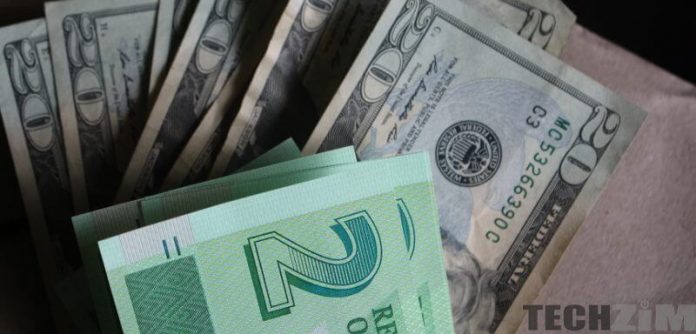Samuel Mapuranga
Zimbabwe’s five-year de-dollarization strategy leading up to the year 2024, which was un-procedurally released on Wednesday revealed that the country would phase out the issue of foreign currency such as US dollars for the payment of local transactions at the end of 2022.
In March, the Reserve Bank of Zimbabwe re-introduced the use of US dollars on local transactions, ditching the managed float exchange rate system in favor of a fixed float regime at a rate of 25. This comes at a time when policymakers globally are implementing a raft of stopgap measures to ease the impact of COVID-19. The Zimbabwean government implemented a 21-day national lockdown on March 30, in a bid to curb the spread of Covid-19 in the country and has now extended by a further two weeks. Residents have complained on the risks exacerbated by the situation in an economy characterised by a large informal sector.
While many countries have attempted to de-dollarize, only a few have succeeded in these efforts. Dollarisation can be reversed through long, consistent and credible stabilization efforts. An effective de-dollarization strategy requires a mix of sound macroeconomic policies, micro prudential measures, and sustained efforts to create the conditions for longer-domestic capital market development. Measures that provide market-based incentives are most successful, while administrative measures aimed at forcing de-dollarization can easily backfire and could encourage capital flight and reduce financial sector intermediation, ultimately hindering growth.
The status quo is not sustainable however, addressing the currency issue will require an increase in reserves, an improvement in fiscal balance and generous donor funding. The decision to allow the use of foreign currency for local transactions, despite an earlier ban, was meant to ease the twin shock faced by the country. However, the general attitude of the Zimbabweans towards their economic circumstances in the last few years clearly put them way ahead of several other people the world over in terms of how they underplay serious problems. It is apparent that we treat dangerous issues too lightly to our own detriment. Ours is a tragedy of inaction, where salvation is held outside self, but within the realms of some “benevolent leadership” whose legitimacy we cannot publicly scrutinise. This has developed into a scenario where not many policies go through the normal process of citizen input and broad-based consultation. Monetary concerns have been dominating the economic outlook with currency puzzle taking centre stage in a country struggling with acute shortages of essentials including medicines, cash and power.
Given the rate at which the ZimDollar has been losing its purchasing power, which we will generalise as value, it is unlikely that the citizens will present the resentment to a new currency. In February 2019, the Zimbabwe dollar was trading at $2.50 to the US$ when it was re-introduced as the RTGS dollar but, has fallen to Z$25 on interbank and Z$47 on the parallel market. The central bank abandoned a “managed float” exchange rate system last month in a bid to ease the impact of COVID-19. Prices of basic commodities however, continued to expand as economic deterioration worsened in the Southern African nation experiencing acute shortage of foreign currency, portable water, electricity and fuel. Prior to the announcement of SI 85/20, government has been making various exemptions to businesses while some had slipped back into accepting the US dollar due to the continuous depreciation of the local currency.
There is clear evidence that in the last few years we have had a good number of policy inconsistencies and policy reversals whose overall effect has been to weaken the credibility of policy and the regime generating those policies. The expenditures directed towards the non-productive activities have had a significant influence on the fiscus, creating a situation we now call “economic crisis”. Its existence, which used to be subject of heated debate in the late 1990s is no longer in question, rather the debate has taken a new twist with the theme now being the causes of the crisis and the way forward. In most cases the objectivity on the various issues has been lost, with political inclination deciding the virtues of what should otherwise be the domain of intellect (technocrats). Some strange arguments that violate all economic logic and rationale have been advanced to justify certain perspectives.
There is need to restore confidence in our financial sector policies through consistency and predictability. Policies must have the input of all interest groups to promote ownership and easy implementation. There is need to restore confidence in the country’s economy collectively as stakeholders in order to bring down inflation as a very important factor in solving the crisis.
The Currency Value
At independence in 1980, Zimbabwe replaced the Rhodesian currency with a new currency. The ratio of the new currency to the old was one-to-one. The implications, if you may ask, are very clear. It was a “change of colours” whose effect at best symbolic.
In real terms the exchange rate of the new currency remained at Z$1:US$1.4. A non-event! Of course, it sounds like it. The purchasing power of the currency maintained the previous trends. The interest here could be on how the transition was managed. Since the Zimbabwean currency was very strong against the major currencies, the issue of introducing a stronger currency to replace an old currency did not arise. It was rather easy to eliminate the old currency from circulation.
To digress a little bit, the feudal lords in Japan were in 1869 prohibited by the imperial power to issue notes, such that only the government could establish a standard currency. The replacement was not complete until 1879. Why then did it take them a decade to convince people to abandon the notes issued by local clans? A closer look at the events would reveal that the people had immense confidence in the old localised currencies, and they did not realise the merits of the new. We, however, cannot overlook the lack of coordination and the difficulties of enforcement that characterised the society of the day. Incoherent policy making.
At a time when the people no longer have confidence in the local currency, the pre-conditions for a change of currency build up. The following key points are indicators to the effect that the ZimDollar has lost credibility: The disappearance of the local currency from the formal financial system. The general dislike by citizens (both corporate and individuals) to keep their assets in the form of local currency. This has been more apparent from the low savings the people are keeping at financial institutions. Secondly, the rush to withdraw cash by individuals and the failure of the business community to deposit most of their cash collections. High inflation rates, which now exceed 600%. Annual inflation reached 676.39% in March. Foreign currency reserves have been dwindling and the nation has struggled to attract fresh capital, in large part because of policy uncertainty and lack of genuine economic and political reforms.
In conclusion, a proper sequencing of policies is critical. The credibility of monetary policy needs to be re-established as a first step. Given the prevailing conditions, the country’s liquidity and broader economic crisis will persist for some time yet.
___________________________________________________________________________
Samuel Mapuranga writes in his own personal capacity. The views expressed in this article are those of the author and do not necessarily represent any organisation. Feedback: Email – [email protected]; or Twitter: @Sa_miiM











